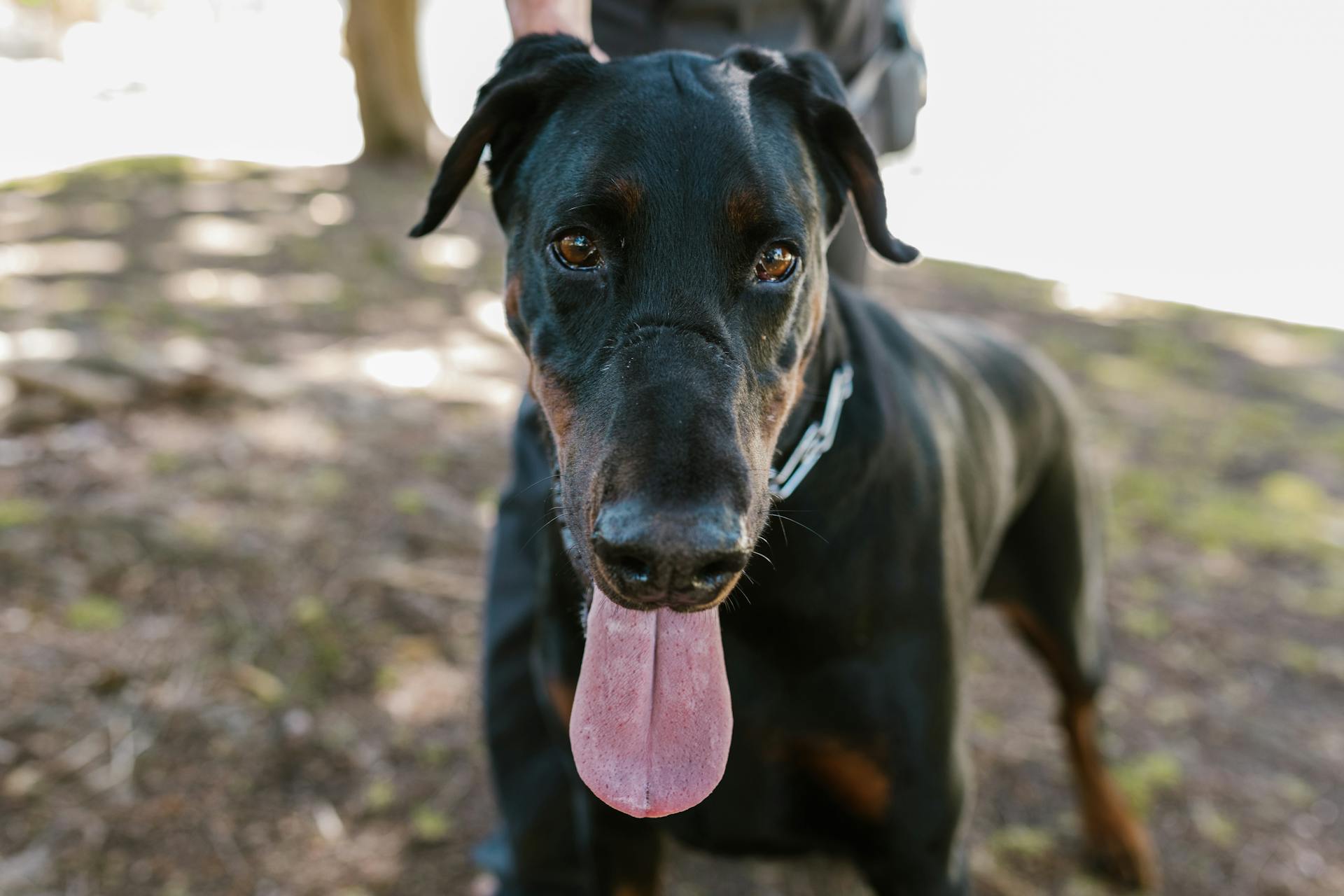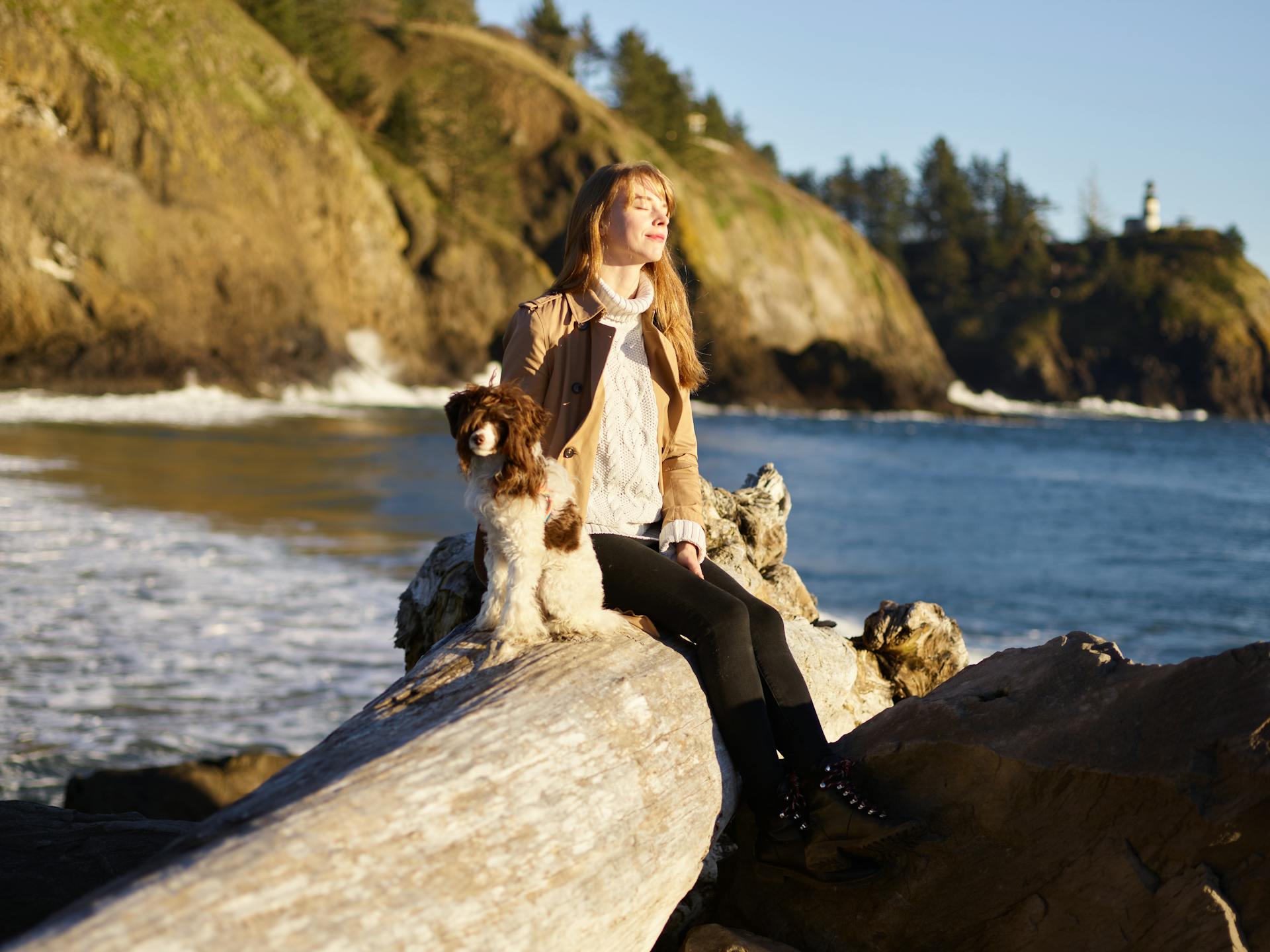
The Doberman Pinscher is a breed with a rich and fascinating history that spans over a century. They were first bred in Germany in the late 1800s by Friedrich Louis Dobermann, a tax collector and dog breeder.
Their original purpose was to serve as both guard dogs and police dogs, due to their intelligence, loyalty, and athleticism. Dobermans quickly gained popularity as a versatile breed that excelled in various roles.
In the early 20th century, the breed gained international recognition and was officially recognized by the American Kennel Club in 1908.
Explore further: Best Breed Dobermans
Doberman History
The Doberman Pinscher breed has a rich history that spans over a century. Karl Friedrich Louis Dobermann, a German tax collector and night watchman, is credited with developing the breed in the late 19th century. He was born in 1834 and died in 1894.
Dobermann was inspired to create a new breed of guard dog that would serve to protect him while doing his various work duties. He aimed to create a dog that was courageous, intelligent, and had a strong mouth and good nose.
Check this out: Doberman Pinscher Breed Standard
The first Doberman Pinschers were bred in the town of Apolda, Thuringia, Germany, and made their first appearance in 1876. The breed was initially known as "Thuringian pinschers" or "Dobermann's Hunde."
Louis Dobermann worked as a tax collector, policeman, night watchman, dogcatcher, and caretaker of the town's dog pound. He was a multifaceted individual who needed a loyal companion and protector.
The Doberman Pinscher breed was officially recognized by the German Kennel Club in 1900. Otto Goeller, a breeder, played a pivotal role in shaping the Doberman into a more trainable and practical dog.
The breed was initially bred for its functionality, with German breeders prioritizing its bravery, intelligence, and toughness. However, this focus gave the breed a reputation for being headstrong and aggressive.
The Doberman Pinscher made its way to the United States around 1908, where it quickly gained popularity. One of the first Dobermans shown in conformation reportedly won "Best in Show" honors at three consecutive events.
For more insights, see: German Pinscher vs Doberman
Breed Overview
The Doberman Pinscher breed has a rich history that spans over a century. Originally bred for protection, the breed has evolved significantly over time.
The breed's foundation is attributed to the German Pinscher, Rottweiler, Weimaraner, Old German Shepherd, Black and Tan Manchester Terrier, and Black English Greyhound. These breeds contributed to the Doberman's unique characteristics, including its intelligence, physical ruggedness, and hunting ability.
Here are the key breeds that make up the Doberman Pinscher:
- German Pinscher
- Rottweiler
- Weimaraner
- Old German Shepherd
- Black and Tan Manchester Terrier
- Black English Greyhound
- Beaucerons and early sheep herding dogs
Today, the Doberman Pinscher is bred for its even-tempered nature and companionship, rather than its original purpose of protection or working ability.
Doberman Pinscher Breeds
The Doberman Pinscher breed has a fascinating history, and understanding its origins can give you a better appreciation for this amazing dog. The breed's background is a bit murky, but it's thought to have been influenced by several other breeds.
The German Pinscher contributed quick reaction timing to the mix, which is a crucial trait for a breed bred for protection. The early Rottweiler added bravery and guarding ability, while the Weimaraner brought hunting, scenting, and retrieving skills to the table.
The Old German Shepherd (now extinct) contributed intelligence and physical ruggedness, which are still hallmarks of the breed today. The Black and Tan Manchester Terrier and Black English Greyhound also had a hand in shaping the Doberman's appearance.
Here are some of the breeds that are thought to have contributed to the Doberman Pinscher:
- German Pinscher
- Early Rottweiler
- Early Weimaraner
- Old German Shepherd (now extinct)
- Black and Tan Manchester Terrier
- Black English Greyhound
- Beaucerons and early sheep herding dogs
As the breed evolved, its purpose shifted from protection to companionship, and today's Dobermans are known for their even-tempered nature.
AKC & FCI Dobermans
The AKC and FCI Dobermans have a rich history in the United States. In 1907, two quality Dobermanns, Annagret II v Thueringen and Claudius v Thueringen, were imported from Germany and became the foundation of quality Doberman breeding in America.
Annagret II v Thueringen and Claudius v Thueringen were two of the first quality Dobermanns to be imported to the United States in 1907. The Doberman breed was first registered with the American Kennel Club in 1908.
On a similar theme: Two Doberman Pinschers
One of the first Manchester Terrier crosses in the breed's history was made with Lady v Ilm-Athen, a dog that was part Manchester Terrier. Unfortunately, this cross resulted in a reduction in the breed's sharpness.
In 1909, Prinz Modern V Ilm-Athen, a popular stud dog, was imported to America. He was the progeny of Greif v Groenlan and Lady v Ilm-Athen, and was known for his conformation, but unfortunately transmitted his lack of courage.
By 1920, there were only 45 registered Dobermans in America. That same year, some of Germany's top dogs were imported to America, including a Holland bred male named Benno vom Roemerhof.
In 1921, Prinz Favorit v.Koningstad, a large Dutch brown male, was imported to America and contributed greatly to the American gene pool.
Curious to learn more? Check out: English Bull Terrier Evolution
Detailed History
Karl Friedrich Louis Dobermann, a night watchman in Apolda, Germany, is credited with developing the Doberman breed. He was born on February 2, 1823.
Dobermann worked as an official of the court of alderman, dogcatcher, and night police officer, and he needed a loyal companion and protector. He acquired a female dog named Bisart, who accompanied him on his rounds and was instrumental in breeding the early Doberman Pinschers.
The first Doberman Pinschers made their appearance in 1876 and received a warm reception. However, the knowledge of the breeds used in the creation of the Doberman Pinschers was lost after Louis Dobermann's death in 1894.
German breeders prioritized functionality over appearance, aiming to develop the Doberman into a highly capable "super dog." They focused on breeding the bravest, smartest, quickest, and toughest dogs, giving the breed a reputation for being headstrong and aggressive.
A breeder named Otto Goeller played a pivotal role in shaping the Doberman into a more trainable and practical dog. In 1900, the German Kennel Club officially recognized the Doberman Pinscher as a distinct breed.
The Doberman Pinscher made its way to the United States around 1908, with one of the first Dobermans shown in conformation reportedly winning "Best in Show" honors at three consecutive events. However, not before anyone dared to check the dog's teeth.
Take a look at this: German Doberman Pinscher
The Doberman Pinscher Club of America was established in 1921, adopting the breed standard written in Germany a year later. The following 15 years were crucial for a Doberman's development, as economic difficulties during World War I caused a decline in Doberman's in Europe.
With the outbreak of World War II, the Doberman Pinscher was again in peril in Germany, but due to earlier importations, the breed had already been secured in the United States.
Frequently Asked Questions
What are the two types of Doberman pinschers?
There are two main types of Doberman Pinschers: the American and European varieties, each with distinct physical characteristics. The American Doberman is sleeker, while the European Doberman is more muscular with a deeper chest.
How to tell the difference between American and European Doberman?
To identify a European Doberman, look for a slightly larger and more muscular build, with a broader chest. This distinctive physique is a result of breeding to the FCI's breed standards.
Featured Images: pexels.com


